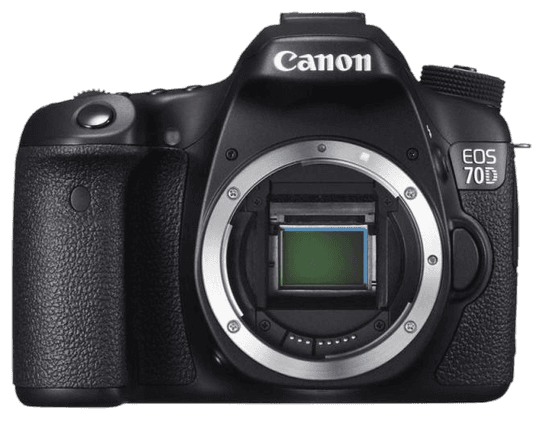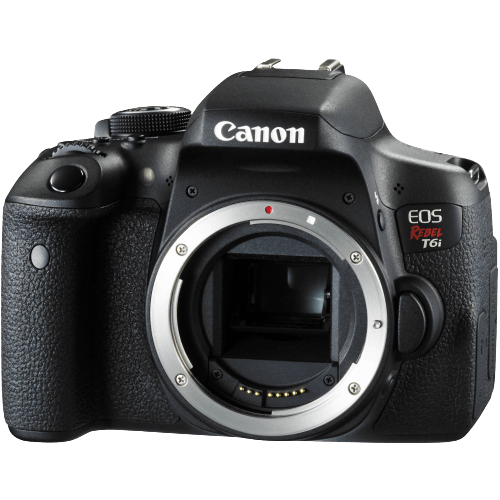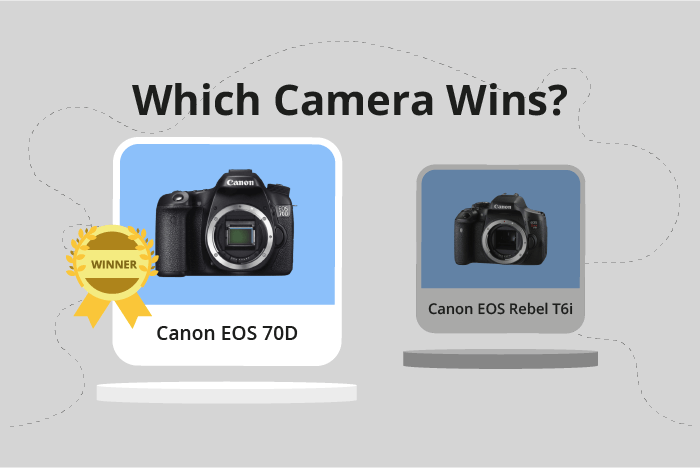Canon EOS 70D vs EOS Rebel T6i / 750D Comparison
Canon EOS 70D

Canon EOS Rebel T6i / 750D

The Canon EOS 70D emerges as the winner with a score of 60/100, while the Canon EOS Rebel T6i / 750D scores slightly lower at 56/100. Both cameras are DSLRs and were released in 2013 and 2015, respectively. They share similar dimensions, with the 70D measuring 139 x 104 x 79mm and the T6i measuring 132 x 101 x 78mm.
The 70D has an edge with its higher score, but it is also heavier at 755g compared to the T6i’s 555g. On the other hand, the T6i is more affordable with a launch price of $750, while the 70D was introduced at $1199.
Considering these points, the Canon EOS 70D is a better camera due to its higher score, but the Canon EOS Rebel T6i / 750D offers a lighter and more budget-friendly option. Each camera has its own strengths and weaknesses, making the choice dependent on individual preferences and needs.
Canon EOS 70D vs EOS Rebel T6i / 750D Overview and Optics
The Canon EOS Rebel T6i / 750D wins in the optics comparison with a score of 59/100, while the Canon EOS 70D scores 58/100. Both cameras share several common specifications such as a CMOS sensor, APS-C sensor size, Canon EF-S lens mount, and no image stabilization.
The Rebel T6i / 750D outperforms the 70D in terms of megapixels and DXOMARK sensor score. With 24.2 megapixels, the Rebel T6i / 750D captures more detailed images compared to the 70D’s 20.2 megapixels. Additionally, the Rebel T6i / 750D has a higher DXOMARK score for the sensor at 71, while the 70D scores 68, indicating better overall sensor performance.
On the other hand, the 70D has a faster shooting speed of 7 frames per second (fps) compared to the Rebel T6i / 750D’s 5 fps. This makes the 70D more suitable for capturing fast-moving subjects and action photography. The 70D also has a more advanced processor, the Digic 5+, which contributes to its faster shooting speed.
In the optics comparison, the Canon EOS Rebel T6i / 750D is the winner due to its higher megapixel count and superior sensor performance. However, the Canon EOS 70D offers a faster shooting speed, making it a better choice for action photography. Both cameras have their strengths and weaknesses, so the best choice depends on the specific needs and preferences of the photographer.
Canon EOS 70D vs EOS Rebel T6i / 750D Video Performance
The Canon EOS 70D and the Canon EOS Rebel T6i/750D have the same video capabilities, as they both scored 43 out of 100. These cameras share several video specifications, which include a maximum video resolution of Full HD, maximum video dimensions of 1920 x 1080, and a maximum video frame rate of 30fps. Additionally, neither camera has built-in time-lapse functionality.
Since both cameras have the same score, it is essential to analyze their respective strengths and weaknesses. The Canon EOS 70D does not have any significant advantages over the Canon EOS Rebel T6i/750D in terms of video capabilities, as they both offer the same video features.
Similarly, the Canon EOS Rebel T6i/750D does not have any notable advantages over the Canon EOS 70D in terms of video capabilities. Both cameras provide the same video performance, making it difficult to determine a clear winner in this aspect.
Given the identical video capabilities of the Canon EOS 70D and the Canon EOS Rebel T6i/750D, the choice between these two cameras should be based on other factors, such as price, ergonomics, and additional features. It is essential for potential buyers to consider their specific needs and preferences when making a decision, as the video performance of these cameras is equal.
Canon EOS 70D vs EOS Rebel T6i / 750D Features and Benefits
The Canon EOS 70D wins the features comparison with a score of 70/100, while the Canon EOS Rebel T6i / 750D scores 57/100. Both cameras share several common specifications, including a 3-inch screen size, 1,040,000-dot screen resolution, touchscreen capability, flip screen, GPS, WiFi, and lack of Bluetooth.
The Canon EOS 70D outperforms the Rebel T6i / 750D in several aspects. Its higher feature score reflects its superiority in terms of camera capabilities. The 70D is an ideal choice for photographers who prioritize advanced features and overall performance.
On the other hand, the Canon EOS Rebel T6i / 750D, although scoring lower in features, still offers some advantages. Its lower score does not necessarily make it a bad camera. Instead, it caters to a different group of photographers who may prioritize affordability and ease of use over advanced features. The Rebel T6i / 750D is a reliable option for beginners and casual photographers.
In comparing the Canon EOS 70D and the Canon EOS Rebel T6i / 750D, it is clear that the 70D is the superior camera in terms of features. However, the Rebel T6i / 750D remains a viable option for those who have different priorities in their photography needs. Ultimately, the choice between these two cameras depends on the user’s preferences and requirements.
Canon EOS 70D vs EOS Rebel T6i / 750D Storage and Battery
The Canon EOS 70D outperforms the Canon EOS Rebel T6i / 750D in storage and battery, scoring 37/100 compared to the Rebel T6i’s 24/100. Both cameras share similarities in storage options, with each having one memory card slot and accepting SD, SDHC, and SDXC cards. However, the Rebel T6i is compatible with the faster UHS-I cards, giving it an advantage in data transfer speeds.
The main difference between the two cameras lies in their battery life. The EOS 70D has a significantly longer battery life, providing 920 shots per charge, while the Rebel T6i only manages 440 shots. Both cameras use different battery types, with the 70D using the LP-E6 and the Rebel T6i using the LP-E17. Neither camera offers USB charging.
In terms of storage and battery, the Canon EOS 70D is the superior choice, mainly due to its longer battery life. The Rebel T6i has the advantage of faster memory card compatibility, but this is not enough to compensate for its shorter battery life.
Alternatives to the Canon EOS 70D and EOS Rebel T6i / 750D
Are you still undecided about which camera is right for you? Have a look at these popular comparisons that feature the Canon EOS 70D or the Canon EOS Rebel T6i / 750D:

